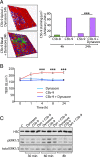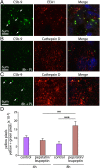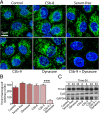Retinal Pigment Epithelial Cells Mitigate the Effects of Complement Attack by Endocytosis of C5b-9
- PMID: 26324770
- PMCID: PMC4574521
- DOI: 10.4049/jimmunol.1500937
Retinal Pigment Epithelial Cells Mitigate the Effects of Complement Attack by Endocytosis of C5b-9
Abstract
Retinal pigment epithelial (RPE) cell death is a hallmark of age-related macular degeneration. The alternative pathway of complement activation is strongly implicated in RPE cell dysfunction and loss in age-related macular degeneration; therefore, it is critical that RPE cells use molecular strategies to mitigate the potentially harmful effects of complement attack. We show that the terminal complement complex C5b-9 assembles rapidly on the basal surface of cultured primary porcine RPE cells but disappears over 48 h without any discernable adverse effects on the cells. However, in the presence of the dynamin inhibitor dynasore, C5b-9 was almost completely retained at the cell surface, suggesting that, under normal circumstances, it is eliminated via the endocytic pathway. In support of this idea, we observed that C5b-9 colocalizes with the early endosome marker EEA1 and that, in the presence of protease inhibitors, it can be detected in lysosomes. Preventing the endocytosis of C5b-9 by RPE cells led to structural defects in mitochondrial morphology consistent with cell stress. We conclude that RPE cells use the endocytic pathway to prevent the accumulation of C5b-9 on the cell surface and that processing and destruction of C5b-9 by this route are essential for RPE cell survival.
Copyright © 2015 The Authors.
Figures





Similar articles
-
Should I stay or should I go? Trafficking of sub-lytic MAC in the retinal pigment epithelium.Adv Exp Med Biol. 2014;801:267-74. doi: 10.1007/978-1-4614-3209-8_34. Adv Exp Med Biol. 2014. PMID: 24664707 Review.
-
Decreased membrane complement regulators in the retinal pigmented epithelium contributes to age-related macular degeneration.J Pathol. 2013 Apr;229(5):729-42. doi: 10.1002/path.4128. Epub 2013 Jan 24. J Pathol. 2013. PMID: 23097248 Free PMC article.
-
Protective responses to sublytic complement in the retinal pigment epithelium.Proc Natl Acad Sci U S A. 2016 Aug 2;113(31):8789-94. doi: 10.1073/pnas.1523061113. Epub 2016 Jul 18. Proc Natl Acad Sci U S A. 2016. PMID: 27432952 Free PMC article.
-
Sublytic membrane-attack-complex activation and VEGF secretion in retinal pigment epithelial cells.Adv Exp Med Biol. 2012;723:23-30. doi: 10.1007/978-1-4614-0631-0_4. Adv Exp Med Biol. 2012. PMID: 22183311 No abstract available.
-
Complement C5b-9 and Cancer: Mechanisms of Cell Damage, Cancer Counteractions, and Approaches for Intervention.Front Immunol. 2019 Apr 10;10:752. doi: 10.3389/fimmu.2019.00752. eCollection 2019. Front Immunol. 2019. PMID: 31024572 Free PMC article. Review.
Cited by
-
Aging of the eye: Lessons from cataracts and age-related macular degeneration.Ageing Res Rev. 2024 Aug;99:102407. doi: 10.1016/j.arr.2024.102407. Epub 2024 Jul 6. Ageing Res Rev. 2024. PMID: 38977082 Free PMC article. Review.
-
In vitro Measurement of Membrane Attack Complex in RPE Cells.Bio Protoc. 2021 Feb 20;11(4):e3916. doi: 10.21769/BioProtoc.3916. eCollection 2021 Feb 20. Bio Protoc. 2021. PMID: 33732803 Free PMC article.
-
Associations between the Complement System and Choroidal Neovascularization in Wet Age-Related Macular Degeneration.Int J Mol Sci. 2020 Dec 21;21(24):9752. doi: 10.3390/ijms21249752. Int J Mol Sci. 2020. PMID: 33371261 Free PMC article. Review.
-
Membrane Attack Complex Mediates Retinal Pigment Epithelium Cell Death in Stargardt Macular Degeneration.Cells. 2022 Nov 2;11(21):3462. doi: 10.3390/cells11213462. Cells. 2022. PMID: 36359858 Free PMC article.
-
Targeting complement components C3 and C5 for the retina: Key concepts and lingering questions.Prog Retin Eye Res. 2021 Jul;83:100936. doi: 10.1016/j.preteyeres.2020.100936. Epub 2020 Dec 13. Prog Retin Eye Res. 2021. PMID: 33321207 Free PMC article. Review.
References
-
- Mettu P. S., Wielgus A. R., Ong S. S., Cousins S. W. 2012. Retinal pigment epithelium response to oxidant injury in the pathogenesis of early age-related macular degeneration. Mol. Aspects Med. 33: 376–398. - PubMed
-
- Johnson L. V., Ozaki S., Staples M. K., Erickson P. A., Anderson D. H. 2000. A potential role for immune complex pathogenesis in drusen formation. Exp. Eye Res. 70: 441–449. - PubMed
Publication types
MeSH terms
Substances
Supplementary concepts
Grants and funding
LinkOut - more resources
Full Text Sources
Other Literature Sources

